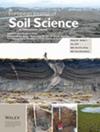FeOx-Driven Soil Aggregation Boosts MAOC Accumulation and POC Protection in Subtropical Mixed Conifer–Broadleaf Forests
Abstract
The conversion of pure coniferous plantations to coniferous–broadleaf mixed forests increases the organic carbon (OC) content of soil and aggregates; however, the mechanisms of OC retention through soil aggregation remain inadequately understood. We selectively removed Fe oxides and OC from soil of both poorly aggregated (pure coniferous plantation) and well aggregated (mixed forest) soil systems. The mechanism of particulate organic carbon (POC) and mineral-associated organic carbon (MAOC) sequestration in Fe oxide soil aggregation under broadleaf transformation was studied. The removal of Fe oxides broke the macroaggregates into microaggregates and < silt + clay fractions and revealed the attachment and entanglement effects of plant residues encapsulated by macroaggregates on soil particles, whereas plant residue decomposition maximised the degree of macroaggregate fragmentation (64.8%–100%). These results indicate that POC self-isolates and that the presence of Fe oxides further enhances POC physical occlusion during soil aggregation. The extent of this physical protection provided by Fe oxides follows the order: free Fe (FeD) > amorphous Fe (FeO) > complex Fe (FeP). Specifically, FeO and FeP promote macroaggregate formation through organic–inorganic complexes (MAOC formation) to enhance POC physical occlusion, whereas FeD predominantly forms inorganic–inorganic complexes. Microaggregate formation and MAOC accumulation occurred simultaneously through organic–inorganic interactions with various Fe oxide forms. These processes enhanced soil aggregation and were accompanied by significant accumulation of POC (80.2%–169.8%) and MAOC (41.1%–137.3%) after stand conversion (p < 0.05). These findings indicate that improved soil aggregation capacity mediated by Fe oxides during forest conversion promotes POC and MAOC accumulation through distinct Fe oxide-specific aggregation mechanisms.




 求助内容:
求助内容: 应助结果提醒方式:
应助结果提醒方式:


